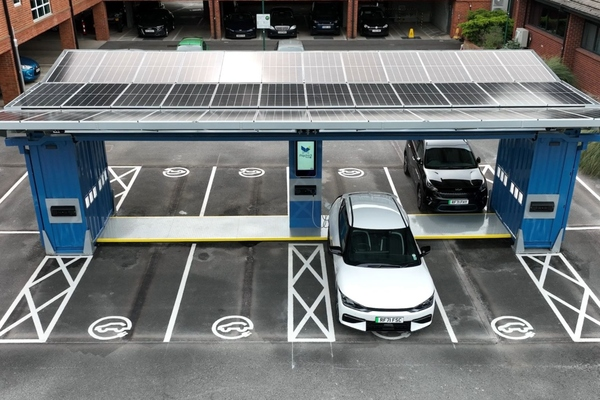In an era where urban congestion and pollution are pressing global issues, the rise of electric vehicles (EVs) offers a promising solution. According to a recent report by Bloomberg Green, global EV sales have surged by 43% in the first half of 2023, emphasizing the growing shift towards sustainable mobility. But as more EVs hit the roads, the demand for efficient charging infrastructure becomes critical. Enter urban EV charging hubs—innovative solutions that are not only transforming city transport but also redefining our urban landscapes. In this article, you’ll discover how these hubs are shaping sustainable mobility, the technology behind them, and practical tips for integrating EVs into your daily commute.
The Rise of Urban EV Charging Hubs
What Are Urban EV Charging Hubs?
Urban EV charging hubs are strategically located stations designed to cater to the high-density areas of cities. These hubs offer multiple charging points, often equipped with fast-charging technology, to accommodate a large number of vehicles simultaneously. Key features include:
- Fast Charging Capabilities: Stations that can charge a vehicle up to 80% in less than 30 minutes.
- Renewable Energy Sources: Many hubs are powered by solar panels or other renewable resources.
- Integration with Public Transport: Located near public transit stations to encourage multi-modal transport solutions.
Why Are They Essential?
The International Energy Agency (IEA) reports that urban areas account for over 70% of CO2 emissions. By facilitating the transition to electric transport, charging hubs can significantly reduce urban pollution. Moreover, they help alleviate range anxiety—a common concern among potential EV buyers—by ensuring that drivers have accessible charging options.
The Technology Driving Urban Charging Solutions
Innovations in Charging Technology
The evolution of battery technologies, as reported by Battery University, is pivotal in the development of urban charging hubs. Current advancements include:
- Solid-State Batteries: Offering higher energy density and faster charging times.
- Bidirectional Charging: Allows EVs to supply energy back to the grid, stabilizing energy demand.
- Wireless Charging: Technology that enables charging without physical connectors, enhancing convenience.
Smart Grids and Energy Management
Smart grids play a crucial role in the efficient operation of charging hubs. By utilizing real-time data and artificial intelligence, these grids can:
- Optimize Energy Distribution: Ensure that charging is done during off-peak hours to reduce costs and grid stress.
- Monitor Energy Usage: Provide users with insights into their consumption patterns and environmental impacts.
Practical Tips for Using Urban EV Charging Hubs
How to Maximize Charging Efficiency
For those new to EVs, here are some practical tips to ensure a seamless charging experience:
- Plan Your Route: Use apps like PlugShare or ChargePoint to locate the nearest charging hubs along your route.
- Check Availability: Real-time data on app platforms can help you find available charging stations, reducing wait times.
- Understand Charging Speeds: Familiarize yourself with different charging levels—Level 1 (slow), Level 2 (moderate), and DC Fast Charging (fast)—to choose the best option based on your time constraints.
Where to Find Charging Hubs
Many cities worldwide are investing in expansive charging networks. Notable examples include:
- London: Plans to install over 7,000 new charging points by 2025 as part of its Ultra Low Emission Zone initiative.
- San Francisco: With its “EV Ready” ordinance, the city aims to equip 10% of new parking spaces with charging stations.
- Shanghai: Boasting more than 200,000 charging points, the city leads in EV infrastructure.
Urban Charging Hubs: A Catalyst for Change
What to Compare When Choosing an EV
When selecting an EV, consider the following:
- Range: Determine how far you need to travel daily and choose a model that offers a comfortable range.
- Charging Compatibility: Ensure the vehicle is compatible with the charging infrastructure in your area.
- Cost: Evaluate the total cost of ownership, including potential savings on fuel and maintenance.
Future Trends in Urban Mobility
Urban EV charging hubs are not just a trend; they are a vital component of the future of urban mobility. As cities continue to expand their charging networks, we can expect:
- Increased Public-Private Partnerships: Collaborations to fund and expand infrastructure.
- Integration with Autonomous Vehicles: Charging hubs may serve as docking stations for self-driving EVs.
- Enhanced User Experience: Advances in technology will make charging more intuitive and user-friendly.
Conclusion: Embracing the Shift to Sustainable Urban Transport
Urban EV charging hubs are undeniably shaping the future of city transport. By providing accessible and efficient charging solutions, they facilitate the widespread adoption of electric vehicles, reducing urban emissions and contributing to a cleaner, greener future. As a reader, you are now equipped with insights into the significance of these hubs and practical tips for their use. Are you ready to embrace this shift towards sustainable mobility? Consider how integrating an EV into your lifestyle could benefit not only you but also the environment. As cities continue to innovate, the possibilities for sustainable urban transport are boundless, paving the way for a cleaner, smarter future.

